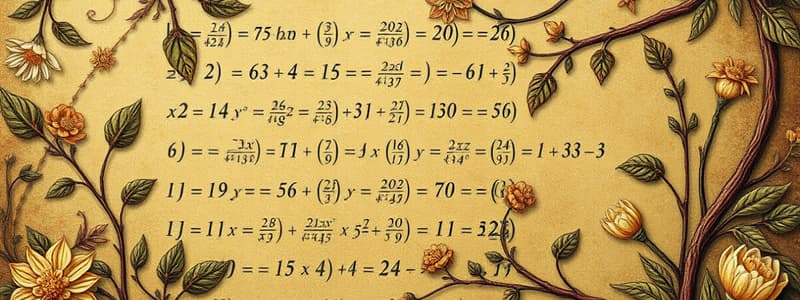Podcast
Questions and Answers
What do I have right?
What do I have right?
what I got right
How many roots does the equation -2x^3 = 0 have?
How many roots does the equation -2x^3 = 0 have?
3
Which polynomial equation is of least degree and has -1, 2, and 4 as three of its roots?
Which polynomial equation is of least degree and has -1, 2, and 4 as three of its roots?
x^3 - 5x^2 + 2x + 8 = 0
Which polynomial equation of least degree has -2, -2, 3, and 3 as four of its roots?
Which polynomial equation of least degree has -2, -2, 3, and 3 as four of its roots?
What are the roots in the equation x^4 + 3x^2 - 4 = 0?
What are the roots in the equation x^4 + 3x^2 - 4 = 0?
What is the least possible degree of a polynomial that has roots -5, 1 + 4i, and -4i?
What is the least possible degree of a polynomial that has roots -5, 1 + 4i, and -4i?
Which options CANNOT be the degree of a polynomial that has only imaginary roots and no real root? (Select all that apply)
Which options CANNOT be the degree of a polynomial that has only imaginary roots and no real root? (Select all that apply)
What is the least possible degree of a polynomial that has the root -3 + 2i, and a repeated root -2 that occurs twice?
What is the least possible degree of a polynomial that has the root -3 + 2i, and a repeated root -2 that occurs twice?
Which is a possible number of distinct real roots for a cubic function? (Select all that apply)
Which is a possible number of distinct real roots for a cubic function? (Select all that apply)
How many complex roots does the equation x(x^2 - 4)(x^2 + 16) = 0 have?
How many complex roots does the equation x(x^2 - 4)(x^2 + 16) = 0 have?
How many real roots does the function y = (x - )(x + )^2 have?
How many real roots does the function y = (x - )(x + )^2 have?
What are all the roots of the equation (x^2 + 1)(x^3 + 2x)(x^2 - 64) = 0?
What are all the roots of the equation (x^2 + 1)(x^3 + 2x)(x^2 - 64) = 0?
What are the roots of x^4 - 81 = 0, x^4 + 10x^2 + 25 = 0, and x^4 - x^2 - 6 = 0?
What are the roots of x^4 - 81 = 0, x^4 + 10x^2 + 25 = 0, and x^4 - x^2 - 6 = 0?
What are the roots in the equation x^3 - 27 = 0?
What are the roots in the equation x^3 - 27 = 0?
Which polynomial equations have -i as one of their roots? (Select all that apply)
Which polynomial equations have -i as one of their roots? (Select all that apply)
Write a polynomial equation of degree 3 such that two of its roots are 2 and an imaginary number.
Write a polynomial equation of degree 3 such that two of its roots are 2 and an imaginary number.
Find all the roots of the equation x^4 - 2x^3 + 14x^2 - 18x + 45 = 0 given that 1 + 2i is one of its roots.
Find all the roots of the equation x^4 - 2x^3 + 14x^2 - 18x + 45 = 0 given that 1 + 2i is one of its roots.
What are the roots of the equation (x^2 - 1)(x^2 + 2)(x + 3)(x - 4)(x + 1) = 0?
What are the roots of the equation (x^2 - 1)(x^2 + 2)(x + 3)(x - 4)(x + 1) = 0?
Flashcards are hidden until you start studying
Study Notes
Fundamental Theorem of Algebra
- Establishes that every non-constant polynomial function over the complex numbers has at least one complex root.
- A polynomial of degree n has exactly n roots, counted with multiplicity.
Roots of Polynomial Equations
- The equation -2x³ = 0 has 3 roots.
- Polynomial x³ - 5x² + 2x + 8 = 0 has roots -1, 2, and 4, indicating it is of least degree 3.
- Polynomial equation (x + 2)²(x - 3)² = 0 has roots -2 (double root) and 3 (double root), indicating a least degree of 4.
Finding Roots
- The equation x⁴ + 3x² - 4 = 0 has roots: -1, 1, 2i, -2i.
- A polynomial must have a degree of 5 to accommodate roots -5, 1 + 4i, and -4i.
- Imaginary roots only: the degree cannot be 3 or 7.
Real Roots in Polynomial Functions
- A polynomial with roots including -3 + 2i and a repeated root -2 has a least degree of 4.
- A cubic function can have possible distinct real roots of 2, 3, or 0.
Complex Roots in Given Equations
- x(x² - 4)(x² + 16) = 0 has 2 complex roots.
- (x² + 4)(x + 5)² = 0 has 4 complex roots.
- x⁶ - 4x⁵ - 24x² + 10x - 3 = 0 has 6 complex roots.
- x⁷ + 128 = 0 has 7 complex roots.
- (x³ + 9)(x² - 4) = 0 has 5 complex roots.
Graphing and Roots
- The graphed polynomial function has 2 real roots and 4 total roots.
- Equation can be expressed as y = (x - a)(x + b)² indicating roots at -a and b.
Solving Polynomial Equations
- For (x² + 1)(x³ + 2x)(x² - 64) = 0, roots include: i, -i, 0, i√2, -i√2, 8, -8.
- For the equation x⁴ - 81 = 0, the roots are 3, -3; for x⁴ + 10x² + 25 = 0, the roots are i√5, -i√5; for x⁴ - x² - 6 = 0, roots include √3, -√3, i√2, -i√2.
Additional Polynomial Equations
- For x³ - 27 = 0, factored as (x + 3)(x² - 3x + 9) = 0.
- Polynomials x³ + 3x² + x + 3 = 0 and x³ - 6x² - 16x + 96 = 0 both have -i as a root.
- Example polynomial of degree 3 with roots 2 and an imaginary number is expressed as y = (x - 2)(x - i)(x + i).
Roots Calculation from Given Root
- For x⁴ - 2x³ + 14x² - 18x + 45 = 0, given 1 + 2i is a root, find all roots by division or substitution methods, leading to further roots calculations.
Studying That Suits You
Use AI to generate personalized quizzes and flashcards to suit your learning preferences.




